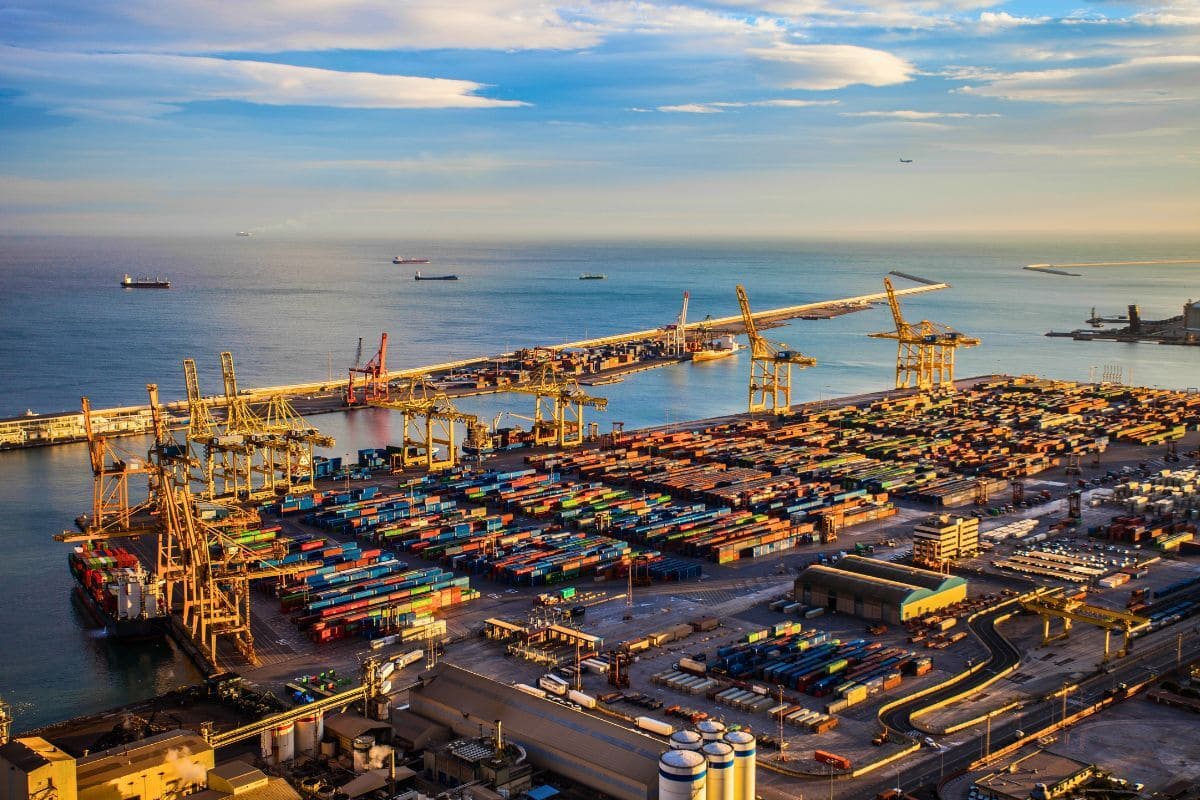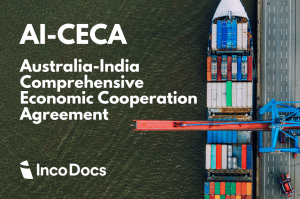In 2024, the largest container ports in the Unites States and Canada are evaluated based on the volume of containers they process, measured in TEUs (Twenty-foot equivalent units). Alongside this, the total weight of goods they handle is also considered. This combination provides a clear picture of their operational scale and significance in global trade about the largest ports in North America. Read more what is a TEU?
These locations are central to the US and Canadian economies, facilitating vast amounts of international commerce. They are essential for linking domestic markets with global trade routes and significantly influence both local and national economic activities. Their role in moving goods across borders makes them fundamental to trade operations.
Port of Oakland
The Port of Oakland, located on the eastern shores of San Francisco Bay in Oakland, California, serves as a vital hub for maritime trade on the West Coast of the United States. Established in 1927, it ranks as the fifth busiest container port in the United States, handling a diverse array of cargo including containers, bulk, and breakbulk commodities.
Key statistics for the Port of Oakland include:
- Annual Container Volume: Approximately 2.07 million TEUs in 2023. ¹
- Economic Contribution: The Port of Oakland generates 98,345 local jobs and contributes over $174 billion to the economy through business revenue, consumer spending, and the total value of goods and services. ¹
- Environmental Initiatives: Leader in green port technologies and practices and is committing to be a Zero Emissions port.
Port of Charleston
The Port of Charleston, located in South Carolina, is a major seaport along the Atlantic Coast. Renowned for its deep waters and strategic access, it serves as a crucial gateway for international trade and commerce. The port’s facilities span several terminals and is renowned for its capability to handle a vast array of cargo types, making it a vital component in international trade networks.
Key statistics for the Port of Charleston include:
- Annual Container Volume: Approximately 2.6 million TEUs in 2023 ²
- Major Exports and Imports: Includes automobiles, machinery, and consumer goods.³
- Economic Impact: Major contributor to local and state economies, supporting thousands of jobs.
Port of Seattle – Tacoma
The Port of Seattle-Tacoma, also known as the Northwest Seaport Alliance, is a critical hub on the West Coast of the United States, strategically positioned in the Puget Sound region of Washington State. Established as a joint venture in 2015, this collaboration between the Port of Seattle and the Port of Tacoma combines their cargo operations to create one of the largest container gateways in North America.
Key statistics for the Port of Seattle-Tacoma include:
- Annual Container Volume: Manages approximately 2.97 million TEUs in 2023. ⁴
- Environmental Initiatives: Committed to reducing emissions and improving air quality around the port area.
Port of Houston
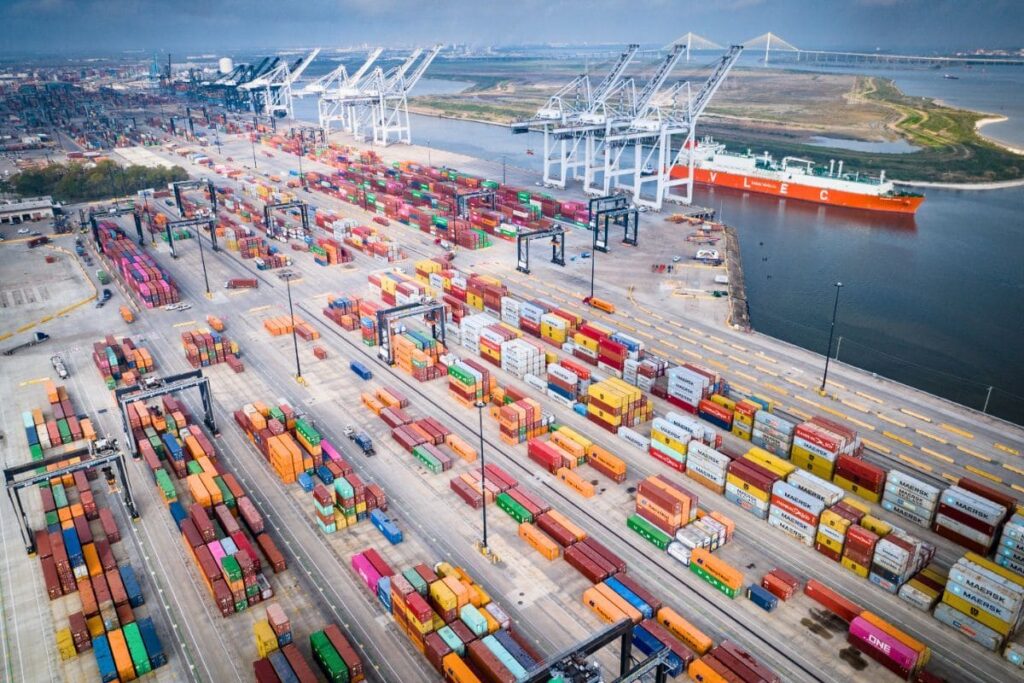
The Port of Houston is a vital gateway for international trade in the United States, located on the Gulf Coast in Texas. It stands out as one of the busiest ports in the nation, primarily due to its strategic position which facilitates trading links between the Americas and major global markets. The port handles a wide range of cargo, including oil, consumer goods, and industrial products.
Key statistics for the Port of Houston include:
- Annual Container Volume: Over 3.82 million TEUs in 2023. ⁵
- Total Tonnage: Manages approximately 50.32 million tons in 2023. ⁵
- Economic Impact: Generates over $439 billion for the state economy in 2023. ⁶
- Employment: Supports more than 1.5 million jobs in various sectors related to trade and transportation. ⁶
Port of Virginia
The Port of Virginia, strategically positioned along the Mid-Atlantic coast, is a pivotal maritime gateway serving the Eastern United States. Established in 1607 as part of America’s earliest settlements, it has evolved into a modern hub of international trade. The port operates several terminals equipped to handle a wide variety of cargoes, including containers, bulk commodities, and breakbulk items. It is renowned for its deep channels that accommodate some of the largest vessels in the world. This port is strategically positioned to serve both the Atlantic routes and inland transportation via its network of railways and highways, facilitating efficient trade flows to and from the interior of the country.
Key statistics for the Port of Virginia include:
- Annual Container Volume: Around 3.82 million TEUs in FY ’21 ⁷
- Employment: Supports over 397,000 jobs directly and indirectly connected to port activities.
Port of New York / New Jersey
The Port of New York and New Jersey, established in 1921, serves as the principal gateway for goods entering and exiting the northeastern United States. Positioned on the Atlantic coast at the mouth of the Hudson River, this bi-state port it is largest port on the east coast. It accommodates a vast array of cargo, including containers, bulk commodities, and vehicles, across several state-of-the-art terminals. The port’s strategic location, combined with its extensive rail and road connections, makes it a critical hub in the North American transportation network.
Key statistics for the Port of New York and New Jersey include:
- Annual Container Volume: Manages over 7.81 million TEUs in 2023. ⁸
- Economic Impact: The Port of New York and New Jersey accounted for nearly $15.7 billion in tax revenue, supported over 563,700 jobs, and was responsible for $47.2 billion in personal and $135.3 billion in business income in the region in 2023 ⁸
- Major Commodities: Includes a diverse range of goods such as electronics, clothing, and vehicles.
San Pedro Bay Port Complex
The Port of Los Angeles and the Port of Long Beach are two distinct entities located next to each other along the San Pedro Bay in California. While they are often collectively referred to as the “San Pedro Bay Port Complex” due to their proximity and combined impact on shipping and logistics, they operate independently and have their own management and operations.
The Port of Los Angeles, is managed by the City of Los Angeles. It is the largest port in North America in terms of shipping container volume and cargo value.
The Port of Long Beach, on the other hand, operates under the Long Beach Harbor Department and is known for being highly automated and one of the greenest ports in the world. It is the second-busiest container port in the United States.
Port of Los Angeles
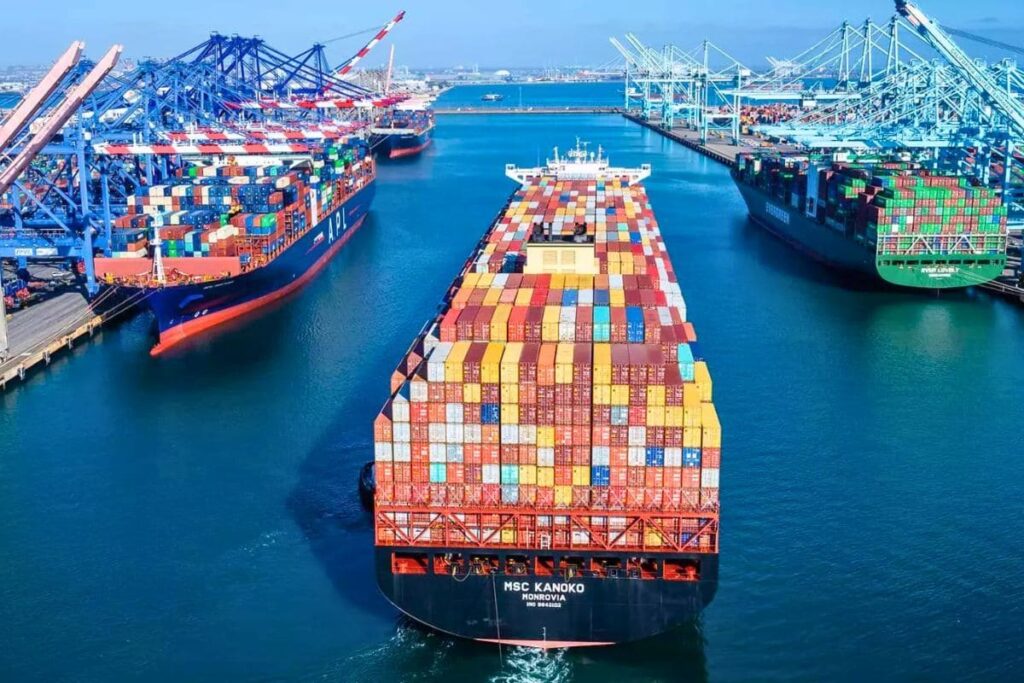
The Los Angeles Port, also known as America’s Port, is the largest container port in the United States. This seaport is managed by the Los Angeles Harbor Department. It plays a pivotal role in international trade, especially with the Asia-Pacific region. This port covers a vast area and handles a significant amount of cargo, making it a major player in global logistics and trade networks.
Key statistics for the Port of Los Angeles include:
- Annual Container Volume: 8.63 million TEUs in 2023. ⁹
- Port Area: Spans roughly 7500 acres (4300 land and 3200 water), equivalent to about 30.35 square kilometers. ¹⁰
- The port has 25 cargo terminals, 82 container cranes, 8 container terminals, and 113 miles (182 km) of on-dock rail.
Port of Long Beach
The Port of Long Beach is a key maritime center on the West Coast of the United States, renowned for its size and the volume of cargo it handles. As the second-busiest container port in the country, it plays a critical role in international trade, especially with the Asia-Pacific region. The port’s advanced facilities and commitment to environmental sustainability make it a leader in the shipping industry.
Key statistics for the Port of Long Beach include:
- Annual Container Volume: 8.02 million TEUs in 2023. ¹¹
- Port Area: Spans roughly 3200 acres, equivalent to about 12.95 square kilometers.
- Environmental Initiatives: Notable for its Green Port Policy aimed at reducing environmental impact.
Port of Montreal
The Port of Montreal is a pivotal maritime gateway located in Quebec, Canada, facilitating trade between North America and international markets. As a versatile port, it handles a diverse range of cargo, including containerized goods, bulk commodities, and liquid bulk. This versatility makes it critical to the supply chains that support various industries across Canada and the northeastern United States.
Strategically situated along the St. Lawrence River, the Port of Montreal is uniquely positioned to serve as a direct link between the industrial heartlands of North America and the Atlantic Ocean. Its efficiency in cargo handling and its robust infrastructure support seamless import and export activities, bolstering the economic growth of Montreal and surrounding regions.
Key statistics for the Port of Montreal include:
- Annual Container Volume: Processes about 1.7 million TEUs in 2022. ¹²
- Major Trade Routes: Serves as a crucial connection point for trade with Europe and the Mediterranean.
- Economic Impact: The Port of Montreal supports 589,364 jobs and generates $93.5 billion in economic activity through its service. ¹²
Port of Vancouver
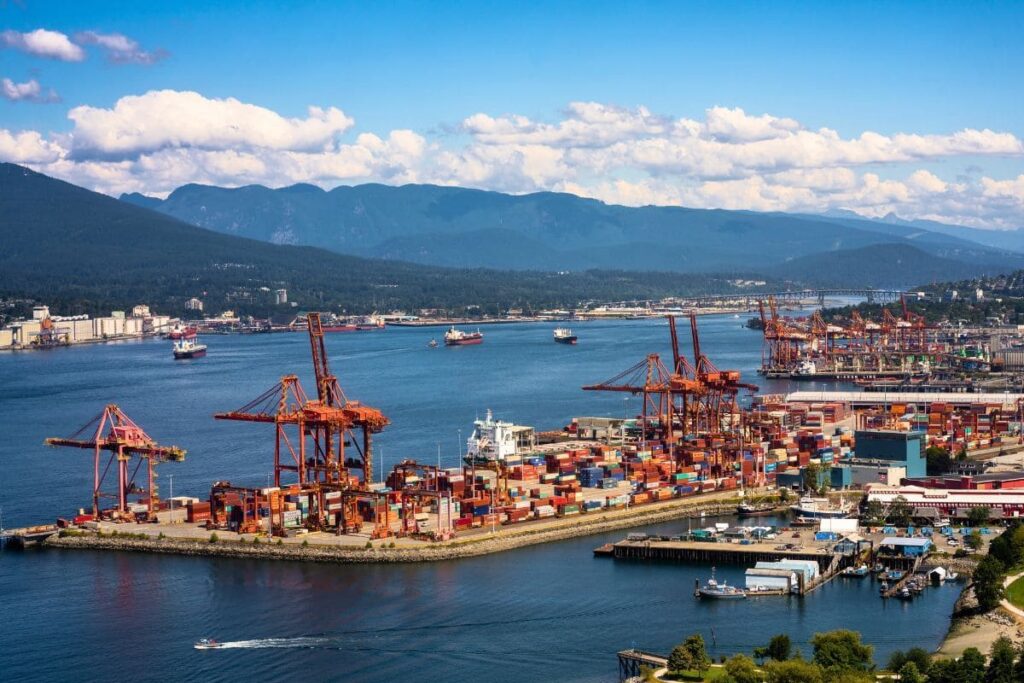
The Port of Vancouver, located in British Columbia, Canada, serves as a primary gateway for trade between North America and Asia. Recognized as Canada’s largest port, it plays a vital role in the country’s economy by managing a high volume of goods transported via marine routes. This port is particularly noted for its efficiency and capacity to handle diverse cargoes, including bulk commodities, containers, and breakbulk items.
Geographically positioned on the west coast, the Port of Vancouver benefits from its proximity to the Pacific Rim, making it an essential node in the trans-Pacific trade corridors. Its advanced infrastructure and commitment to sustainability help in accommodating the growing demands of global trade while minimizing environmental impacts. This ensures that the port continues to operate effectively, supporting Canadian and international markets.
Key statistics for the Port of Vancouver include:
- Annual Container Volume: Processes approximately 3.13 million TEUs in 2023 ¹³
- Total Tonnage: Manages about 150.3 million metric revenue tons last year. ¹³
References
- “Facts & Figures – Oakland Seaport“, Retrieved 2024-04-23
- “SC Ports’ fiscal 2023 ‘a much more typical year’ following cargo boom – FreightWaves“, Retrieved 2024-04-23
- “Charleston, SC | The Observatory of Economic Complexity“, Retrieved 2024-04-23
- “A Strong Finish to 2023 for the NWSA | Northwest Seaport – Port of Tacoma“, Retrieved 2024-04-23
- “Port Houston finishes 2023 strong biggest December on record for loaded exports | AJOT.COM“, Retrieved 2024-04-23
- “PORT HOUSTON RELEASES HOUSTON SHIP CHANNEL ECONOMIC IMPACT STUDY“, Retrieved 2024-04-23
- “Report: Port Helps Drive Economic Investment and Job Creation Throughout the Commonwealth – Port of Virginia“, Retrieved 2024-04-23
- “Port of NY/NJ handles 7.8 million TEUs in 2023 – Container News“, Retrieved 2024-04-23
- “Port of Los Angeles ends 2023 as nation’s busiest port – Port Technology International“, Retrieved 2024-04-23
- “The Nation’s #1 Container Port and the Global Model for Security, Sustainability, and Social Responsibility“, Retrieved 2024-04-23
- “Long Beach surpasses 8 million TEUs in 2023 – Container News“, Retrieved 2024-04-23
- “Port of Montreal results from 2022 operations: back on course with growth – MRO MagazineMRO Magazine“, Retrieved 2024-04-23
- “Port of Vancouver handled record cargo volumes in 2023 due to growth | Urbanized“, Retrieved 2024-04-23
